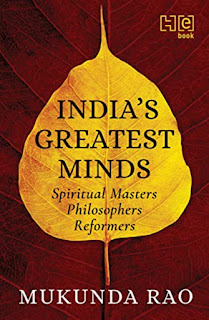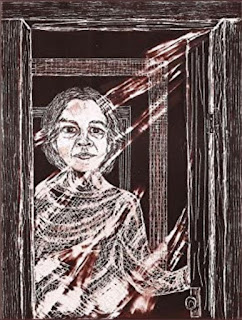Nothing to teach, nothing to offer, nothing at all
The Sunday Observer, Books & Ideas, March 14-20, 1993
By Makarand Paranjape
A random passage from U.G. Krishnamurti makes one shiver with a sense of déjà vu. “You see, ambition is a reality, competition is a reality. But you have superimposed on that reality the idea that you should not be ambitious. It has turned us all into neurotic individuals. We want two things at the same time.” What words are these? Not just the language, even the sense is that of the original Krishnamurti, J.
The similarity is not just in ideas, but also in backgrounds, and even in looks. UG too had an unusual childhood, groomed by his rich grandfather for a spiritual life. He too was closely associated with the Theosophical Society and broke away from it. And UG too has those striking looks, intense eyes and beautiful features; watching him, observing his gestures and mannerisms, reminds one, invariably, of his more famous namesake. What, then, is the exact relationship between the two Krishnamurtis? In a sense, this question lies at the heart of the riddle of who UG is. If we are able to define this relationship exactly, then I think we shall be able to understand UG better.
It is well known that UG has been consistently debunking, attacking, and deriding J. Krishnamurti, whom he calls the “biggest hoax” of the 20th century. When Radha Rajagopal Sloss' salacious and scandalous exposé, Lives in the Shadow of J. Krishnamurti, was published, UG, according to Mahesh Bhatt, gloated. And yet, UG's ideas (he refuses to call them “teachings”) are similar. In fact, it was while listening to Krishnamurti's lecture in Saanen, Switzerland, that UG finally walked out, to face his own “calamity”. Krishnamurti was describing a state which was UG's own, so he felt that it was pointless to go on listening.
Where UG departs from Krishnamurti is in his refusal to believe in any entity such as the mind. Whereas J. Krishnamurti speaks of the ending of thought, the dissolution of the centre, the death of the mind, and so on, UG believes that the mind is a myth, a nonexistent chimera invented by philosophers and gurus. To him the human being is a biochemical organism, that's all. And the body itself is very intelligent, concerned only with its survival. By giving it a false goal, such as the attainment of moksha, we torture it unnecessarily. This makes UG somewhat of a materialist and a cynic.
The “death” experience which UG underwent was, according to him, the death of the body. But, it seems, instead of merely dying, his body revived. Since then he has gone through numerous deaths and revivals. All his talking is merely a description of how he actually functions. He claims that he has nothing to teach, nothing to give others. He cannot help anyone; in fact, he asserts, no one can help anyone else because there is nothing to achieve. The world is all right as it is and we too are quite all right as nature created us. So, to him, all religions and philosophies are humbug. It is his relentless attack on what he sees as sham and hypocrisy that distinguishes UG. He offers nothing and punctures all those who claim to offer anything themselves. In that sense, he is the nihilist par excellence. No doubt, there is something utterly merciless and unfeeling about his criticism; indeed, he has, as his grandfather once commented, “the heart of a butcher.”
In most of his thoughts, UG is merely echoing J. Krishnamurti, who also debunked traditional religions and authority of any kind. UG, however, argues that in doing so, Krishnamurti set up an alternative authority; that he substituted God with a suggested transformation of consciousness; that he continued to offer hope, however indirectly, to his disciples and followers. UG makes it very clear that he wishes to offer no hope at all; he wishes to drive home to us the very hopelessness of our condition. Therefore, UG merely takes Krishnamurti's teaching to its logical extremes, even so far as to render it absurd and futile.
By himself, and on his own terms, UG makes little sense. But when looked at with Krishnamurti's thought in mind, he becomes the culmination of the heterodox tradition of modern Indian mysticism. The orthodox tradition, as exemplified by, say, Sri Ramakrishna Paramahansa, has almost ended up as another organised church, not much different from conventional religion. On the other hand, UG takes us to the brink of the abyss, exhausting the potential of Krishnamurti's philosophy and, indeed, destroying it. While this makes him a “festering splinter that never goes away,” to quote one of his followers, he does perform the salutary and necessary function of clearing whatever garbage and debris was left behind by Krishnamurti.
The best way of describing UG's ministry is to call it anti-philosophy. But if ideas always contain and suggest their opposites, then UG is really no different than all the gurus of India. He too heals, helps, and points the way.
What is interesting about UG's life, however, is the suffering and agony of it. He proved to be unsuccessful at most of his the roles he was called upon to perform, except perhaps his current role as an anti-guru. He was deserted by his father, brought up by his grandfather, with whom he quarrelled, dropped out of college, deserted his wife and children (his wife later went insane), walked out of the Theosophical Society, broke with J. Krishnamurti, and ended up penniless in Saanen, where he had to be “adopted” by a remarkably generous Swiss woman called Valentine de Kerven. Earlier, when he was broke in London, he was sheltered by the Ramakrishna Mission. Thus, in his own life, UG was a bit of a bum, a derelict, who had a broken life.
Similarly, most of his disciples, too, are people with severe emotional and psychological problems. Many of them, like Mahesh Bhatt, come from broken homes themselves. Some, like Parveen Babi, are mentally disturbed. These are people who have all, at one time or another, hit rock bottom; they have left or have been driven out of other ashrams. When they have absolutely nowhere else to go, they turn to UG. As Vijay Anand put it, “He is a friend to you when your own teacher has become your enemy.” Well, so what? Surely, the modern condition demands gurus for tamasic as it does for satvik people. As a person interested in spirituality, I am neither disturbed nor bothered by UG. I think he has made a positive contribution to the continuously evolving discourse of self-discovery and emancipation. All his negativism only functions to clear away the falsehood from our lives.
As to Mahesh Bhatt, his biographer, I must confess that I have mixed feelings. Bhatt's biography leaves much to be desired. There are jumps in chronology and the narrative is patchy; the book seems to have been written in a hurry and is not properly researched. It does offer us much more than the earlier books of or on UG. Yet, as a first biography it does deserve credit.
The main problem with Bhatt's point of view is the peculiar blindness that disciples have about their masters; Bhatt believes that all other gurus are frauds, but UG is not, supposedly because he admits that he has nothing to offer. Such a position makes Bhatt self-righteous, obtuse, and intolerant – “no one, absolutely no one, can now take me for a ride,” he seems to proclaim. But Bhatt should know that no one can either deceive or liberate us; we deceive and liberate ourselves.


